- 1863 Maynard Carbine, .50 Caliber
- 1863 Maynard Carbine, Shoulder Stock
- 1863 Maynard Carbine, Barrel
- 1863 Maynard Carbine, Breech System Lock Plate
- 1863 Maynard Carbine, Open Breech
- 1863 Maynard Carbine, Saddle Sling
- 1863 Maynard Carbine, Rear Sight
- 1863 Maynard Carbine, Front Sight
- 1863 Maynard Carbine, Cartouche
Many of these Carbines were issued to Union Calvary from the 9th and 11th Indiana and the 11th Tennessee. Many of these Carbines are seen in very good condition since most were issued late in the war and many saw little or no service. Many laid in arsenals until the government sold them off in the late 1860’s.
The Maynard Carbine’s are considered one of the best performing and most accurate carbines of the Civil War era. In John D. McAulay,s book “Carbines of the Civil War” he writes in October of 1859 the Navy conducted test firing on the Maynard Carbine at the Washington Navy Yard. Dr. Maynard personally fired a .50 caliber Maynard for the test. A 3×6 foot target was placed at 200 yards, and 237 rounds were fired without a miss. The rate of firing was at 12 rounds per minute. One Maynard was fired 562 times before cleaning. Two of the metallic cartridges were reloaded and fired 200 times and found to still be serviceable.
I would say that’s a Five Star Review of this weapon. With the exception of the Sharps and Spencer it’s my opinion this may have been the best and most reliable Carbine issued during the Civil War. I would have no objections to using this as my primary weapon, back in the day. How about you? The First Model Maynard carbines were manufactured in .35 and .50 Caliber and many of those weapons were purchased by Southern States at the outbreak of the war. So many were purchased that in the Confederate Arms Guide the Maynard was shown as a weapon.
So that brings us to yet another Weapon in my Civil War Arsenal. This 1863 Maynard has 2 government cartouches on the left side of the stock. Most of the bluing is worn off the barrel but no rust or cracks in the stock. This was the first CW weapon I purchased and even though I’ve made some bad purchases over the years, this was a good one considering it was my first, anyone collecting CW stuff knows what I mean.
I guess the most unusual thing about this Carbine is the serial no. is in the 22,000 range, it has government cartouches. Like I said earlier in John D. McAulay’s book “Carbines of the Civil War” 20,002 carbines were procured by the government and Norm Flayderman , documents 20,202 carbines manufactured in his book “Guide to Antique American Firearms” so that makes me question the facts or the lack of. Either way the US Government paid $24.20 for each Carbine and 2,157,000 Maynard Cartridges were bought at a cost of $72,207.50.
If you have any questions contact Eugene West at civilwararsenal@yahoo.com

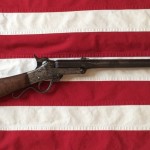
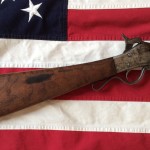
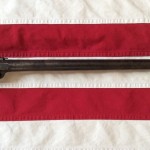
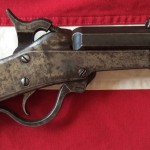
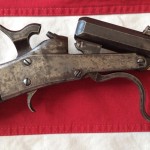
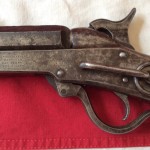
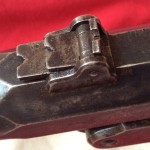
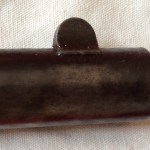
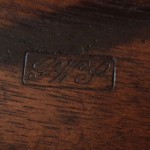
I shoot an original Maynard .50 calibre 2nd Model, serial no. 3720.
It is very accurate, provided I clean the barrel after every 12 shots or so. My Maynard shoots a little low and a little left, but this is easily compensated by adjusting my aim.
It is light, short and easy to load and shoot compared to a typical muzzle loaded long rifle of the day. The offset hammer is only just off centre, so that it partially obscures your field of view, you actually look down the side of the hammer to take aim. Perhaps this was intended to enable rapid sighting at close range.
A very accurate easy to use firearm, that was very popular with confederate troops.
John, Thanks for the info. on your Maynard. It is indeed a nice weapon, especially for it’s time. How did you come by this carbine in the UK?
Does your carbine have U.S. government Cartouches on it? sorry about the questions, It helps me understand the history of American Civil War weapons.
Gene
I have a Maynard carbine Patent dates May 27 1851 Dec 6 1859. On the lower tang is the number 17802 and I presume it to be the serial #.
The bore is very rough but the rifling still shows and it shoots into 12 in. at 50 yards. I have one round of original ammo which I used to take measurements from but have made 4 rounds of brass using 50/70 Govt. ,cutting it back and turning to the correct diameter.
I have been cutting off half of a cast 500 grain bullet (for my 50/70 Springfield trap door) to come up with a 300 grain slug. I can not get 50 grains of FFF in the case so I shoot 40 grains. I think the original must have use a hollow based bullet.
My single example of a 50/50 round is very strange—a very large diameter rim and a cylindrical case wall that is soldered to the base–a very tiny hole for ignition. I am told when loading for the round a piece of silk was used in the bottom of the case to keep the powder from spilling out but I can’t imagine any powder coming out of that little hole.
Standard musket caps set off the charge. I had a heck of a time cleaning the passage way from the nipple to the breach to got it to fire the first time but it was worth it. What a hoot to shoot!!!!
Johnny, Dixie Gun Works offers after market brass cartridges for the 50 caliber Maynard. I’ve bought a half dozen and they work well, I think their about 7 dollars each.
As a young boy growing up in Easton, PA. I had occasion to find a Maynard Carbine in a field next to my house. I played with the rifle for years being told it was
just single barreled shotgun of some type. Eventually my dad took custody of the
weapon and sold it to feed the family. Wish I still had it and had took better care of it. No computers to get info from in the early 50’s. Too bad. Stock had initials
“THP” well carved into it. Sold the weapon to a guy on Morgan’s Hill in Easton, PA.
Gene….are you still answering questions about the Maynard Carbine? I have one with 4 barrels with matching serial numbers …thanks
Jim, what’s the serial # on the weapon and can you send a couple images of i=
t and the barrels……
Good Afternoon,
I have a Maynard Rifle and I’m looking for some info on it. On one side it sad 1873 and on the other it says 1882. The serial number is 22146. Anything helps, thank you!
Chris, I’ve included an attachment below that will help you understand your Maynard better then I could explain…….hope this helps.
Regards Gene West
Good Afternoon Sir,
My name is Chris Elliott and I have a Maynard Carbine I’d like to learn about. I haven’t been able to find much info on it and that’s mostly due to not knowing really where to look. I’m a weapons instructor with the Marine Corps and this weapon pre dates my knowledge and skill. One one side of the rifle it says 1882 and on the other it reads 1873. The serial number is 22146. Any info would be greatly appreciated.
Thank you!
-Sgt. Elliott, USMC
Sir:
I have inherited a fine example of a Maynard Second Model Carbine, and have some questions that you may be able to answer.
There are four very clear cartouches on the left side of the stock; two are “AJN” in fancy script, the other two “H.SCHMIDT” in block letters. Serial number is 15098.
Do you have any information on either of the cartouches and any insight as to when that serial number could have been produced. Since there were about 21,000 made a must assume that it was a late model do you concur?
Thank you for your expert review!
Sincerely,
Michael
Michael,
Below see the attachments I’ve included for most of the information you’ve requested. I don’t believe the H. Schmidt on the stock to be a cartouche, all cartouches that I’ve seen are initials……sometimes the stock maker will stamp his name on that area…..but I’ve never seen an inspector use more then there initials.
ANJ are the initials for the inspector of the Maynard Carbine but there is no record of the name, see below. The serial number places the carbine late war, probably February 1865. Didn’t see much service if any during the war.
It has 2 cartouche, one from when it was purchased it had to go through a quality inspection and the other when it was stored in an armory after war.
Hope I answered all your question, if you have any others feel free to ask.
Regards, Gene
Dear Eugene,
I write today to ask for a copy of the ‘PDF’ you refer to above in earlier queries.Today, while cleaning my reloading bench pile, I unearthed an old Hawthorne Wards shotgun cleaning kit tin filled with the guts of a Second Model Maynard of the 1863 Model. I had previously found last year in my pile of stuff the barrel, which appears to be in pretty good shape, with the lever/link assembly, but though I thought I had the rest, I couldn’t find them at the time.My late dad’s second wife gave the parts to me many years ago and told me they belonged to a relative from days gone by. She is old Southern/Texas stock and I don’t think that Great Uncle was a Yankee.
The markings are MASS ARMS CO , Chicopee Falls. Serial No 14884 all matching on side plate & bottom of tang. The tang location has another small mark like an A with the top truncated, and the side plate location, the number 4 appears to be struck on top of an 8. Looks like the guy screwed up marking it.
All I need is a stock and, from the diagrams, that doesn’t appear to be too complicated. So I am toying with building the rifle back up and seeing if I can make some ammo and fire that puppy up.
I see this thread has recent activity so I would appreciate your help. I have some old walnut that I think would be perfect, but I may find an original/replica for a template. Making ammo is another branch of the tree, and though I reload and have shot Black Powder, never have I ventured this far from the recipe.
Going to post some pics on my Flickr page
Once again thanks,
Sincerely yours,
James K Kavanagh
Finally got those pictures up. If you click on my Blue Name in this forum, it will take you there. I realized one of the screws is snapped, the trigger pivot pin I believe, so I’ll have to figure that out. I am bidding on gunbroker for some old cartridges, 50-50 Maynard 1865 Right?, and hope to learn how to make new ones, bullets etc. I have some old 1×6 walnut that if glued together, I think would make a great stock.
I am amazed by the precision and quality of the parts for this rifle. Everything joins in hairline seams, the mechanism is simple, and evidently the carbine acquitted itself quite well when called upon.
The good Dr Maynard was a founding father of American Dentistry and received many patents. He invented the cap gun. Truly he dwells in the Pantheon of Giants such as Browning, Colt, Stoner.
I will try to contact the web host by the above email ‘civilwararsenal at yahoo dotcom.
Sincerely yours
James K Kavanagh
Hi Eugene West !
I sure hope this is going to work as this
is off a posting from 2013.
Anyway, on the 2nd model maynard carbines, were the
two lugs on the bottom of the barrel originally brazed
on, or were they milled from one piece of steel, with the
barrels screwed in ?
Am retiring in a few months and have a hankering to
make a maynard for myself.
Got to shoot one decades ago, and fell in love, but don’t
have several thousand dollars to buy a replica.
Everything I’ve seen online shows making replicas with
a mono block that the barrel screws into.
But I don’t have the equipment to mill out steel yet. So
brazing would be easier for me. I also shoot nothing
but black powder.
Thank You !
Mike Cummings
Mike,
It’s hard to tell exactly, but I think it’s brazed, below I’ve included two closeup images so you could decide for yourself…..hope this helps and good luck with your project.
Regards, Gene
Hi Gene I have a Maynard serial number 8457 here in the UK just trying to find out abit if it’s history
I need to do something with the Maynard carbine I found while metal detecting. It’s all rusted up without a stock. Where is a good source of information?
Thank You Eugene !
Didn’t get the images, but that’s okay as everything I’ve
seen on the internet appears as brazed on. People today
seem to think that wire welding is the only way to go,
But my Great Grandfather’s 1902 Stevens shotgun is
still functional, and I still use it for bird hunting. All
the old time break opens were just brazed.They didn’t
have anything else back then !
Thanks again ! Mike
Sir,
I purchased a gun collection today and in it was a Maynard Carbine, serial number 18127. The gun has been converted to centerfire and appears to be 22 caliber. Next to the Maynard stamping is the date 1873. Underneath the Mass Arms stamping is 1882. Was wondering if you have any information on the conversion and what exactly I have here. Thanks in advance.
Where could I find the best info about making my Maynard functional again. It needs a stock and is rusted in an open position. Cartridge still in the chamber. Found in Nevada while Metal detecting